26 Mar Papua New Guinea — Sing-Singing on the Sepik River
The Sepik is the longest river in New Guinea,
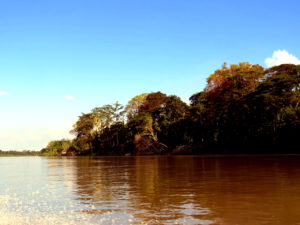
winding from Papua across to the Indonesian side of the island, then looping back.
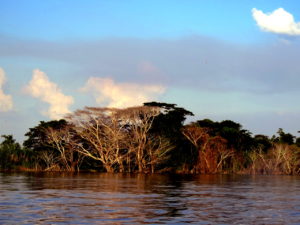
Along the way it passes through dozens of tribes and language groups
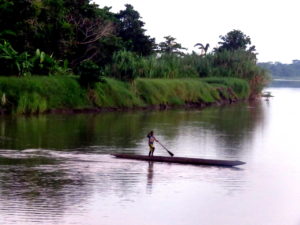
and, since the 1880’s, has been the obvious way for outsiders to get upcountry. Which means that when the group Peggy and were with reached Kanganamun Village we weren’t the first batch of outsiders they’d ever seen.
They put us up in a longhouse raised on posts,
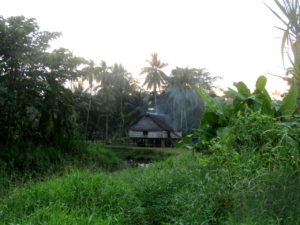
which not only kept us out of the bug zone, but provided a sheltered place for cooking and socializing underneath.
A wide path we were warned not to take led from the rear of the village off through the jungle. Why we weren’t supposed to take the path wasn’t made clear so, at first light, Peg and headed over to see for ourselves.
After about a quarter-mile the path opened onto a grassy area
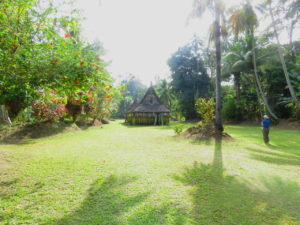
that, except for the spirit house,
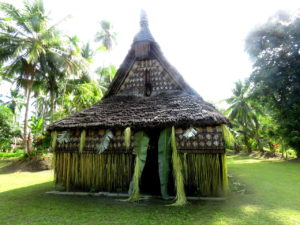
wouldn’t have been out of place on a fancy estate in England.
Thinking this really might be somewhere we weren’t supposed to be, we turned around and headed back the way we’d come, passing villagers bustling along the path who didn’t seem to care one way or the other that we were there. Or, maybe, they were just used to inconsiderate foreigners.
I never quite got a fix on what spirit houses were all about, although they seem to be places for men to pass along tribal lore and customs, initiate boys into manhood, and to store wooden images
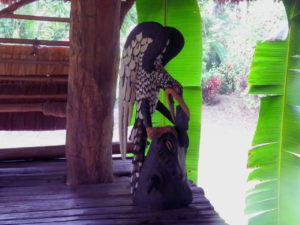
for friendly spirits of nature to come live inside of.
A carving of a couple of birds perched atop a woman standing, knees bent, on a crocodile, looked so much like a totem pole from the Pacific Northwest
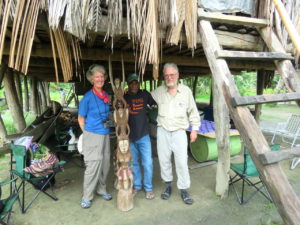
that I asked the gentleman who carved it to tell me the story behind it. That was another thing the spirit house appeared to be, a commercial art gallery with the artist on sight to answer questions.
He told us about a clumsy girl who went out every morning to gather firewood, and every morning broke her father’s stone ax. After one too many axes her family exiled here to a log out in the river, which was okay by the girl until she needed to relieve herself. She became so squirmy a turtle swam up and offered to help. But instead of taking her to the bank he carried her to the bottom of the river, where the crocodile made her his bride. She gave birth to a pair of eggs that hatched into eagles. As they grew, they practiced flying until the older brother popped through the surface and soared above the river. When he returned, the girl asked him to search for the huge tree that marked her village. He found it, and he and his brother flew their mother home.
New Guinea is a land of big trees, so that one must have been a giant and I wanted to see it. But, like a lot of things in legends, the tree wasn’t there anymore.
The spirit house also functioned as a communal cloak room
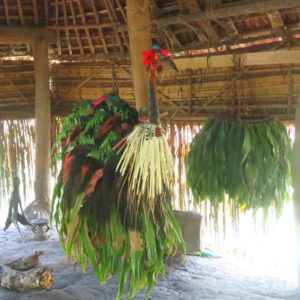
for storing costumes
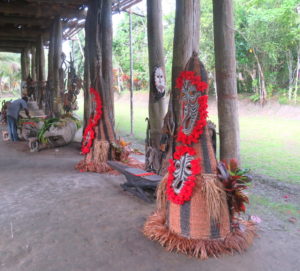
dancers wear in sing-sings.
Sing-sings are a species of pow-wow where people from different communities get together, paint their faces and bodies, dress up om heirloom outfits that go back generations, and dance and sing for one another. Peggy and I spent hours wandering the grassy area, watching the ladies kit up.
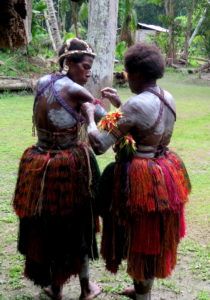
And out among

the surrounding trees,
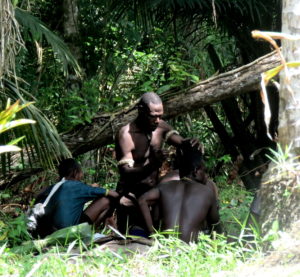
where men helped one each other prepare.
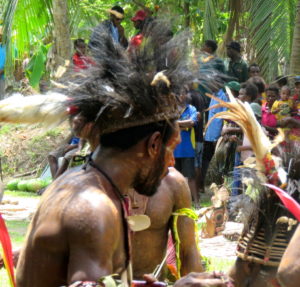
Or in quiet places where mothers
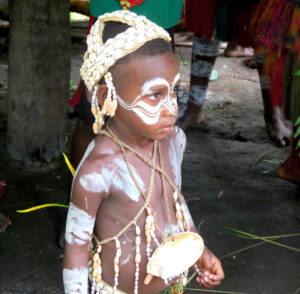
got children ready which, if our wiggly grand kids are any gauge, required an extraordinary amount of patience.
The ceremonies kicked off with men, I suppose they were men, it was hard to know for sure,
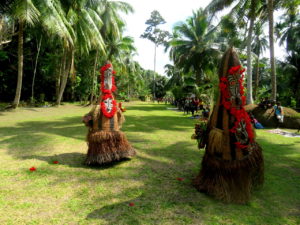
but they came from the direction of the spirit house, so that might have meant something, jumping and turning and swaying back and forth like animated haystacks.
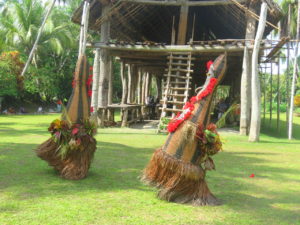
Whatever the sing-sing meant to those men, or to the rest of the dancers, to us it was ancient and unknowable
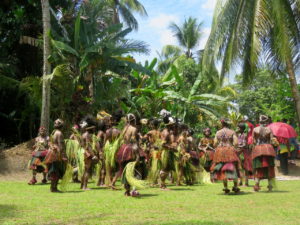
and spoke to something deeply human.
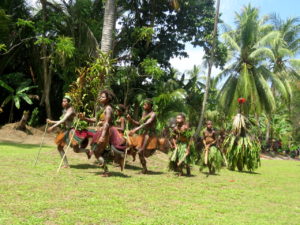
Papuans are among the most ancient populations in the world outside of Africa
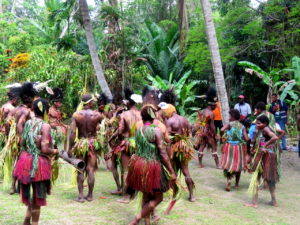
and, since the Sepik is one of the few easy ways into the country,
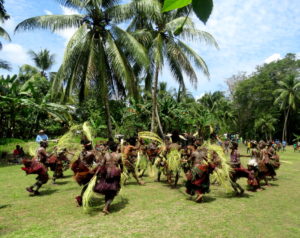
we were watching something that might have taken place in exactly the same way on precisely the same spot
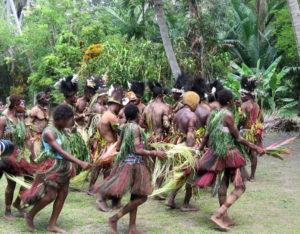
fifty-five, sixty-thousand, years ago.
For a single afternoon, we felt as though we had fallen among our own ancestors, people so far back in time we had almost forgotten who they were. That evening we rejoined them in the spirit house to the sound of drumming and chanting and hollow, wooden instruments from the dawn of people
![]()
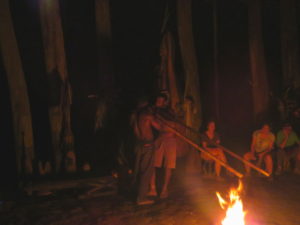
and, this time, it wasn’t as if our ancestors were there with us. It was as if we were our ancestors.
The next morning we were in our canoes and back up river,
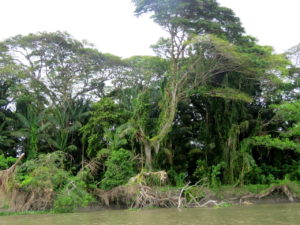
which I wouldn’t have bothered to mention except for the rum. Because there’s one other thing the Sepik River should be famous for but nobody talks about: the rum they sell to the unwary from a little stand where our canoes landed.
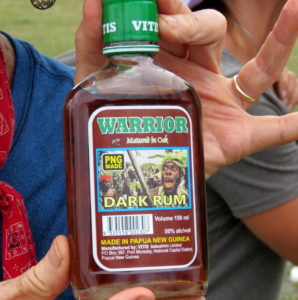
Warrior Rum which is, hands down, the world’s worst. So, if you ever find yourself in the mood for rum that tastes like a mixture of earwax and the creosote they seal up docks with, you know where to look.
.


No Comments